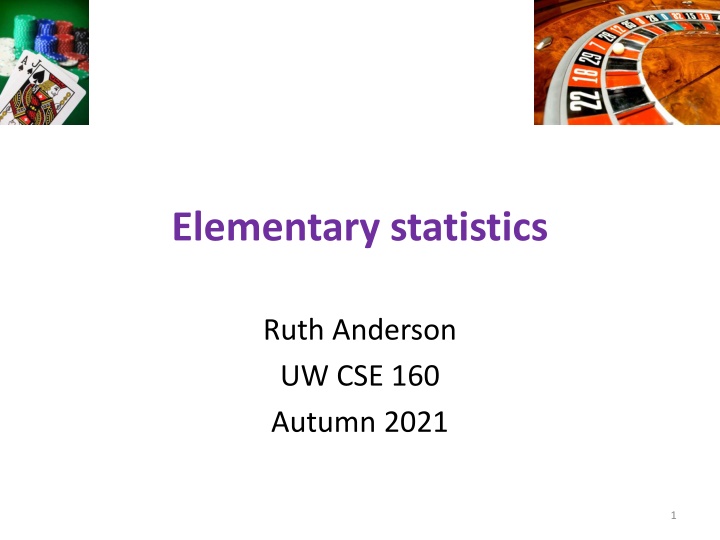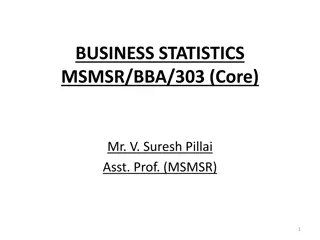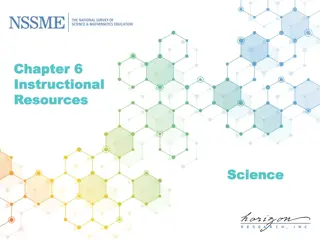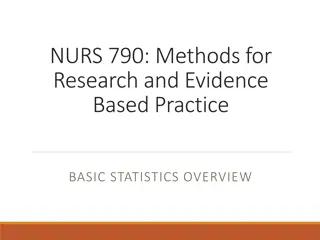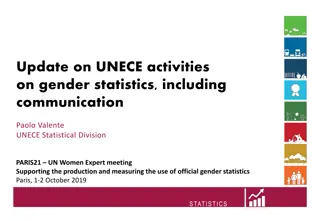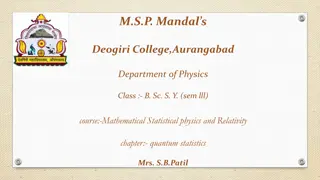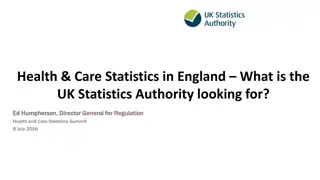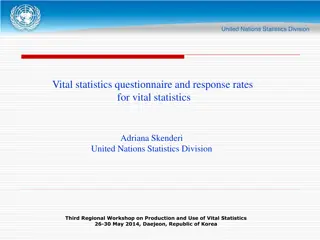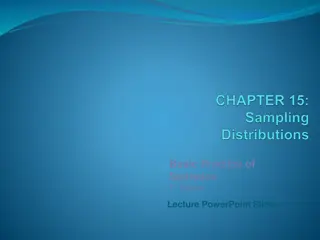Elementary statistics
In this comprehensive guide, explore the world of statistics with a focus on luck, fraud, and hypothesis testing. Discover how statistics can answer critical questions and understand the methodology behind computation and probability in statistical analysis.
Download Presentation

Please find below an Image/Link to download the presentation.
The content on the website is provided AS IS for your information and personal use only. It may not be sold, licensed, or shared on other websites without obtaining consent from the author.If you encounter any issues during the download, it is possible that the publisher has removed the file from their server.
You are allowed to download the files provided on this website for personal or commercial use, subject to the condition that they are used lawfully. All files are the property of their respective owners.
The content on the website is provided AS IS for your information and personal use only. It may not be sold, licensed, or shared on other websites without obtaining consent from the author.
E N D
Presentation Transcript
Elementary statistics Ruth Anderson UW CSE 160 Autumn 2021 1
A dice-rolling game Two players each roll a die The higher roll wins Goal: roll as high as you can! Repeat the game 6 times 2
Hypotheses regarding the outcome Luck Fraud loaded die inaccurate reporting How likely is luck? How do we decide? 3
Questions that statistics can answer I am flipping a coin. Is it a fair coin? How confident am I in my answer? I have two bags of beans, each containing some black and some white beans. I have a handful of beans. Which bag did the handful come from? I have a handful of beans, and a single bag. Did the handful come from that bag? Does this drug improve patient outcomes? Which website design yields greater revenue? Which baseball player should my team draft? What premium should an insurer charge? 4
What can happen when you roll a die? What is the likelihood of each? 5
What can happen when you roll two dice? How likely are you to roll 11 or higher? This probability is known as the p value . 2 3 4 5 6 7 8 9 10 11 12 6
How to compute p values Via a statistical formula Requires you to make assumptions and know which formula to use Computationally (simulation) Run many experiments Count the fraction with a better result Requires a metric/measurement for better Requires you to be able to run the experiments We will use this approach exclusively 7
Aside: Analogy between hypothesis testing and mathematical proofs The underlying logic [of hypothesis testing] is similar to a proof by contradiction. To prove a mathematical statement, A, you assume temporarily that A is false. If that assumption leads to a contradiction, you conclude that A must actually be true. From the book Think Statistics by Allen Downey 8
Summary of statistical methodology 1. Decide on a metric (e.g. bigger value = better) 2. Observe what you see in the real world 3. Hypothesize that what you saw is normal/typical This is the null hypothesis 4. Simulate the real world many times 5. How different is what you observed from the simulations? What percent of the simulation values are the real world values bigger than? 6. If the percentage is 95% or more, reject the null hypothesis 9
Null Hypothesis Null Hypothesis: The common wisdom, nothing unusual is happening here Examples: Ruth was using a fair die The accused is innocent This new drug does NOT cure disease The Iranian election results are accurate 10
Interpreting p values p value of 5% or less = statistically significant This is a convention; there is nothing magical about 5% Two types of errors may occur in statistical tests: false positive (or false alarm or Type I error): no real effect, but report an effect (through good/bad luck or coincidence) If no real effect, a false positive occurs about 1 time in 20 false negative (or miss or Type II error): real effect, but report no effect (through good/bad luck or coincidence) The larger the sample, the less the likelihood of a false positive or negative 11
Errors Type 1: False Positive (false alarm) Type 2: False negative (miss) Examples: Ruth was using a fair die Type 1: Die is actually fair, accuse me of lying! Type 2: Die is actually biased, you don t notice The accused is innocent This new drug does NOT cure disease The Iranian election results are accurate 12
Error Examples Type 1: False Positive (false alarm) Type 2: False negative (miss) Examples: Ruth was using a fair die Type 1: Die is actually fair, accuse me of lying! Type 2: Die is actually biased, you don t notice The accused is innocent Type 1: Type 2: This new drug does NOT cure disease Type 1: Type 2: The Iranian election results are fair/accurate Type 1: Type 2: 13
Answer: Error Examples Type 1: False Positive (false alarm) Type 2: False negative (miss) Examples: Ruth was using a fair die Type 1: Die is actually fair, accuse me of lying! Type 2: Die is actually biased, you don t notice The accused is innocent Type 1: Actually innocent, court finds guilty Type 2: Actually guilty, court sets them free This new drug does NOT cure disease Type 1: Drug actually does nothing, study claims it does Type 2: Drug actually does help, study claims it does not The Iranian election results are fair/accurate Type 1: Results are actually fair, we claim they are fraudulent Type 2: Results are actually fraudulent, we claim they are fair 14
A false positive 15 http://xkcd.com/882/
http://xkcd.com/882/ 16 http://xkcd.com/882/
A common error 1. Observe what you see in the real world 2. Decide on a metric (e.g. bigger value = better) This is backwards For any observation, there is something unique about it. Example: Roll dice, then be amazed because what are the odds you would get exactly that combination of rolls? 17
Statistical significance practical importance 18
Aside: Correlation causation Ice cream sales and rate of drowning deaths are correlated 19 http://xkcd.com/552/
